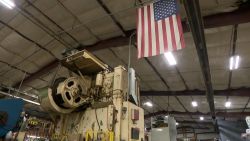The fever hasn’t broken yet for America’s employment market, but the temperature is coming down.
The economy added 263,000 jobs in September, the Bureau of Labor Statistics reported Friday, slightly more than economists had estimated.
While still robust, the headline number marks the second consecutive month of falling totals. That, coupled with job openings showing some sharp declines, points to a labor market slowdown — an outcome the Federal Reserve is seeking as it battles decades-high inflation.
“The job market is slowing gracefully, moderating jobs and wage growth smoothly as the Federal Reserve searches for signs of cooling inflation,” Daniel Zhao, senior economist for Glassdoor, said in a statement. “The job market is doing its part for a soft landing, keeping job gains positive and moderating wage gains.”
Still, one area of concern for the Fed is labor force participation, said Julia Pollak, chief economist at ZipRecruiter. Getting a larger share of people into the workforce can help bring down wage growth, one of several factors Fed officials fear could keep inflation high. The September report showed that labor force participation rate ticked down to 62.3% from 62.4% the month before.
“There was hope that the reopening of schools would have been a great moment for a restart” for many of the people who left the labor force during the pandemic, Pollak told CNN Business. “We may not see some of the people who left come back.”
The unemployment rate for September fell back to its half-century low of 3.5% from 3.7%, a result of the decline in the number of people looking for work.
“The Federal Reserve looks at this and other job market data, along with still hot inflation pressures, and will continue to believe it needs to boost interest rates,” Mark Hamrick, senior economic analyst with Bankrate, said in a statement.
“That appears to be a certainty for the upcoming meeting in early November. The magnitude of future rate hikes will become clearer as we get closer to the final two [policymaking] meetings of the year,” he said.
The Fed meets November 1-2 to discuss monetary policy and is widely expected to raise its benchmark interest rate by three-quarters of a percentage point for an unprecedented fourth time in a row.
Friday’s job report likely won’t sway the Fed from that plan, said Andrew Patterson, senior international economist with Vanguard. What could, however, move the needle will be the findings from the inflation data due next week, he said.
The BLS on Wednesday and Thursday will release the latest Producer Price Index and Consumer Price Index reports, respectively.
“Next week, if there’s another miss to the upside, that’s starting to be a big concern,” he said.
Approaching normal
For the past two years, the labor market has been on a tear, recovering quickly from the massive drop-off of more than 20 million jobs at the onset of the Covid-19 pandemic. The resurgence has come in leaps and bounds: US employers added an average of 562,000 jobs per month last year and 420,000 jobs per month this year.
However, that pace is unsustainable, said Dean Baker, senior economist at the Center for Economic and Policy Research. If monthly job gains edge down to 200,000 or around 150,000, that would likely sit better with the Fed, he said.
During pre-pandemic times, the average monthly job gain was below 200,000, BLS data shows.

It might not be reasonable, however, to assume that certain industries will ultimately return to pre-pandemic employment levels, he noted.
The pandemic forced restaurants to incorporate online ordering, pick-up and delivery on a greater scale, and customers became more comfortable in using those services, he said. Hotels haven’t bounced back fully, but neither has business travel, he said, adding that the rise of Zoom and competitors like Airbnb could continue to result in more muted demand for hotel stays.
“I think what we’re likely seeing is a permanent shift,” he said.
In addition, while private sector employment returned to pre-pandemic levels earlier this year, public sector employment remains nearly 600,000 jobs, or 2.6%, below levels seen in February 2020, BLS data shows.
‘Tale of two job markets’
The recovery remains uneven, and it’s growing more complex as the labor market starts to feel the influence of the Fed’s series of supersized rate hikes, Pollak said.
“I think we’re starting to see the economy turn into a tale of two job markets,” she said.
Employment is surging back in several industries hit hard during the pandemic, including health care, food services and the arts — but industries that are more sensitive to interest rates, such as finance, residential construction and car dealerships, are showing declines, Pollak said.
While declines in these sectors are anticipated during a period of high interest rates, what could be a troubling sign are net job losses in crucial support industries such as local education, child care and trucking, said Russell Weaver, an economic geographer with Cornell University’s ILR School.
From August to September, local public education jobs fell by 22,000; day care services employment fell by 2,000 jobs; and truck transportation fell by 11,000 jobs, according to BLS data. While those declines are small, they are moving in the opposite direction at a critical time.
“Those and a few other sectors have large ripple effects,” Weaver said, noting ongoing supply chain concerns and the ability for people to have reliable education and child care services so that they can return to the workforce. “That can certainly impact [parents’] long-term and future economic and work prospects.”
The Fed, in its latest projections, anticipates that the unemployment rate could climb to 4.4% next year as part of the central bank’s efforts to bring down inflation. But while a broader slowdown could result in economic “pain” (the Fed’s own projections mean that around 1.2 million more people would lose their job), businesses remain in hiring mode. Job openings outpace job seekers on a 1.7 to 1 ratio, the BLS’ Job Openings and Labor Turnover Survey for August showed.
That’s true in Charlotte, North Carolina, where mixed-income residential developer Laurel Street hasn’t taken any available jobs off the table.
“We’re not sensing that a recession is imminent,” said Dionne Nelson, Laurel Street’s chief executive officer and founder. “We’re still very busy. We are still hiring. Our markets are still very active.”
























